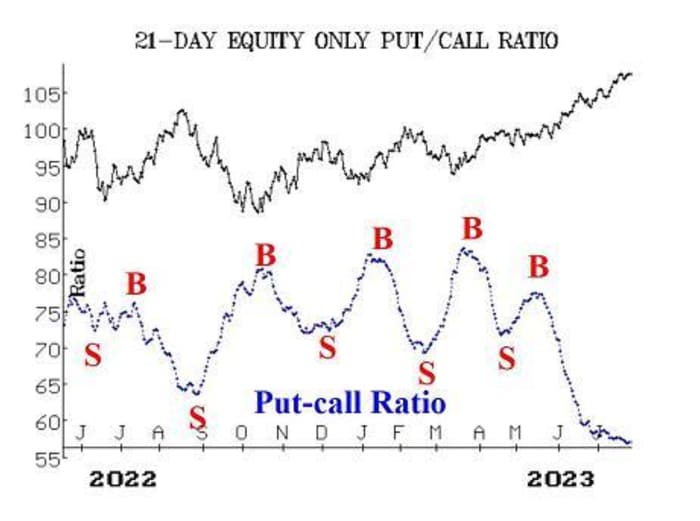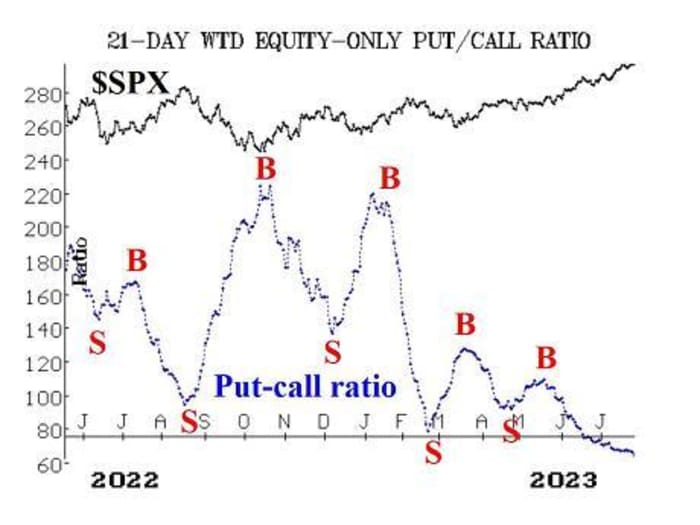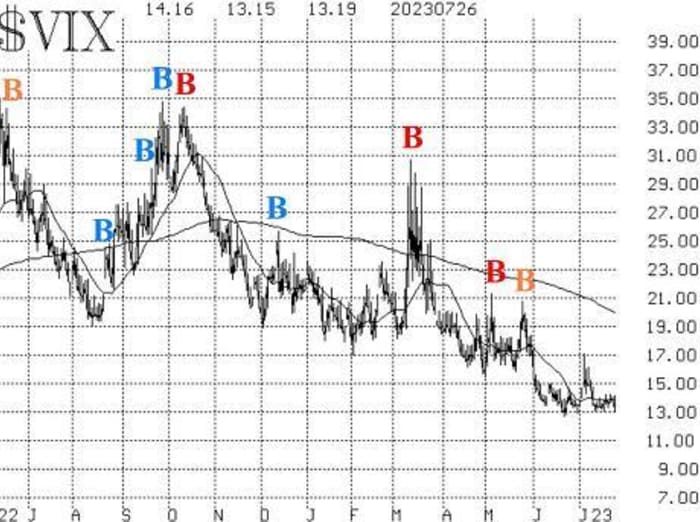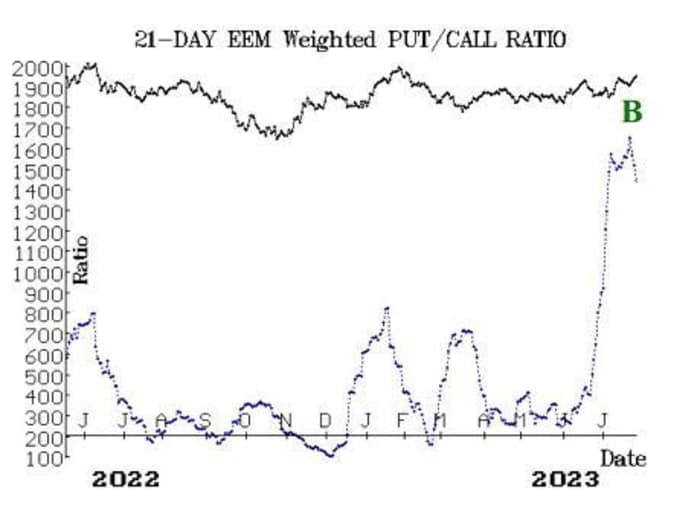The media landscape is going through a difficult transition, and it isn’t only because streaming is such a tricky business.
Companies such as Walt Disney Co.
DIS,
Warner Bros. Discovery Inc.
WBD
and Paramount Global
PARA
have made heavy investments in streaming services as their traditional media businesses wither, only to find that it is harder than it looks to emulate Netflix Inc.’s
NFLX
ability to make money from streaming.
Some of the companies are also saddled by debt, in part resulting from mergers that don’t hold the same shine in the current media landscape.
Needless to say, this is the age of cost-cutting for Netflix’s streaming competitors and many others in the broader media landscape.
Below is a screen of U.S. media stocks, showing the ones that analysts favor the most over the next 12 months. But before that, we list the ones with the highest and lowest debt levels.
All the above-mentioned media companies are in the communications sector of the S&P 500
,
which also includes Alphabet Inc.
GOOGL
GOOG
and Meta Platforms Inc.
META,
as well as broadcasters, videogame developers and news providers.
But there are only 20 companies in the S&P 500 communications sector, which is tracked by the Communications Services Select Sector SPDR ETF
.
High debt
Before looking at the stock screen, you might be interested to see which of the 53 media companies are saddled with the highest levels of total debt relative to consensus estimates for earnings before interest and taxes (EBIT) for the next 12 months, among analysts polled by FactSet. This may be especially important at a time when long-term interest rates have been rising quickly. Dollar amounts are in millions.
| Company | Ticker | Debt/ est. EBIT | Total debt | Est. EBIT | Debt service ratio | Total return – 2023 | Market cap. ($mil) |
| Dish Network Corp. Class A | DISH | 1,245% | $24,556 | $1,973 | 15% | -57% | $1,773 |
| Madison Square Garden Sports Corp. Class A | MSGS | 1,125% | $1,121 | $100 | -14% | -4% | $3,400 |
| Paramount Global Class B | PARA | 656% | $17,401 | $2,654 | -29% | -13% | $9,529 |
| Consolidated Communications Holdings Inc. | CNSL | 651% | $2,152 | $331 | -26% | 6% | $441 |
| TechTarget Inc. | TTGT | 629% | $479 | $76 | 16% | -36% | $788 |
| Cinemark Holdings Inc. | CNK | 616% | $3,630 | $589 | 61% | 81% | $1,908 |
| Cogent Communications Holdings Inc. | CCOI | 548% | $1,858 | $339 | -19% | 27% | $3,388 |
| E.W. Scripps Co. Class A | SSP | 529% | $3,084 | $583 | 80% | -42% | $552 |
| AMC Networks Inc. Class A | AMCX | 492% | $2,945 | $599 | 26% | -29% | $357 |
| Live Nation Entertainment Inc. | LYV | 466% | $8,413 | $1,805 | 135% | 22% | $19,515 |
| Source: FactSet | |||||||
Click on the tickers for more about each company, including business profiles, financials and estimates.
The debt figures are as of the end of the companies’ most recently reported fiscal quarters. The debt service ratios are EBIT divided by total interest paid (excluding capitalized interest) for the most recently reported quarters, as calculated by FactSet. It is best to see this number above 100%. Then again, these service ratios cover only one quarter.
Looking at the most indebted company by quarter-end debt to its 12-month EBIT estimate, it would take more than 10 years of Dish Network Corp.’s
DISH
operating income to pay off its total debt, excluding interest.
Shares of Dish have lost more than half their value during 2023, and the stock got booted from the S&P 500 earlier this year. The company has seen its satellite-TV business erode while it pursues a costly wireless build-out that won’t necessarily drive success in that competitive market. Dish plans to merge with satellite-communications company EchoStar Corp.
SATS
in a move seen as an attempt to improve balance sheet flexibility.
It is fascinating to see that for six of these companies, including Paramount, debt even exceeds the market capitalizations for their stocks. Paramount lowered its dividend by nearly 80% earlier this year as it continued its push toward streaming profitability, and Chief Executive Bob Bakish recently called the company’s planned sale of Simon & Schuster “an important step in our delevering plan.”
You are probably curious about debt levels for the largest U.S. media companies. Here they are for the biggest 10 by market cap:
| Company | Ticker | Debt/ est. EBIT | Total debt | Est. EBIT | Debt service ratio | Total return – 2023 | Market cap. ($mil) |
| Alphabet Inc. Class A | GOOGL | 22% | $29,432 | $133,096 | 711% | 47% | $1,528,711 |
| Meta Platforms Inc. Class A | META | 47% | $36,965 | $78,129 | 717% | 137% | $634,547 |
| Comcast Corp. Class A | CMCSA | 266% | $102,669 | $38,539 | 77% | 33% | $187,140 |
| Netflix Inc. | NFLX | 197% | $16,994 | $8,641 | 192% | 41% | $184,362 |
| T-Mobile US Inc. | TMUS | 378% | $116,548 | $30,838 | 32% | -5% | $156,881 |
| Walt Disney Co. | DIS | 263% | $47,189 | $17,975 | 88% | -4% | $152,324 |
| Verizon Communications Inc. | VZ | 370% | $177,654 | $48,031 | 36% | -11% | $140,205 |
| AT&T Inc. | T | 378% | $165,106 | $43,681 | 31% | -20% | $100,872 |
| Activision Blizzard Inc. | ATVI | 93% | $3,612 | $3,891 | 2159% | 21% | $72,118 |
| Charter Communications Inc. Class A | CHTR | 434% | $98,263 | $22,651 | 89% | 23% | $62,380 |
| Source: FactSet | |||||||
Among the largest 10 companies in the S&P Composite 1500 communications sector by market cap, Charter Communications Inc.
CHTR
has the highest ratio of debt to estimated EBIT, while its debt service ratio of 89% shows it was close to covering its interest payments with operating income during its most recent reported quarter. Disney also came close, with a debt service ratio of 88%.
Charter Chief Financial Officer Jessica Fischer said at an investor day late last year that “delevering would only make sense if the market valuation of our shares fully reflected the intrinsic value of the cash-flow opportunity, if debt capacity in the market were limited or if our expectations of cash-flow growth, excluding the impact of our expansion were significantly impaired.”
Meanwhile, Kevin Lansberry, Disney’s interim CFO, said during the company’s latest earnings call that it had “made significant progress deleveraging coming out of the pandemic” and that it would “approach capital allocation in a disciplined and balanced manner.”
Disney’s debt increased when it bought 21st Century Fox assets in 2019, and the company suspended its dividend in 2020 in a bid to preserve cash during the pandemic.
When Disney announced its quarterly results on Aug. 9, it unveiled a plan to raise streaming prices in October. Several analysts reacted positively to the price increase and other operational moves.
Read: The long-simmering rumor of Apple buying Disney is resurfacing as Bob Iger looks to sell assets
The largest companies in the sector, Alphabet and Meta, have relatively low debt-to-estimated EBIT and very high debt-service ratios. Netflix has debt of nearly twice the estimated EBIT, but a high debt-service ratio. For all three companies, debt levels are low relative to market cap.
Low debt
Among the 52 companies in the S&P Composite 1500 communications sector, these 10 companies had the lowest total debt, relative to estimated EBIT, as of their most recent reported fiscal quarter-ends:
| Company | Ticker | Debt/ est. EBIT | Total debt | Est. EBIT | Debt service ratio | Total return – 2023 | Market cap. ($mil) |
| New York Times Co. Class A | NYT | 0% | $0 | $414 | N/A | 32% | $6,968 |
| QuinStreet Inc. | QNST | 18% | $5 | $26 | -153% | -35% | $513 |
| Alphabet Inc. Class A | GOOGL | 22% | $29,432 | $133,096 | 711% | 47% | $1,528,711 |
| Shutterstock Inc. | SSTK | 26% | $63 | $241 | 39% | -20% | $1,502 |
| Yelp Inc. | YELP | 31% | $106 | $344 | 78% | 55% | $2,909 |
| Meta Platforms Inc. Class A | META | 47% | $36,965 | $78,129 | 717% | 137% | $634,547 |
| Scholastic Corp. | SCHL | 54% | $108 | $201 | 319% | 12% | $1,314 |
| Electronic Arts Inc. | EA | 73% | $1,951 | $2,678 | 605% | -2% | $32,425 |
| World Wrestling Entertainment Inc. Class A | WWE | 93% | $415 | $448 | 479% | 66% | $9,455 |
| Activision Blizzard Inc. | ATVI | 93% | $3,612 | $3,891 | 2159% | 21% | $72,118 |
| Source: FactSet | |||||||
New York Times Co.
NYT
takes the prize, with no debt.
Wall Street’s favorite media companies
Starting again with the 52 companies in the sector, 46 are covered by at least five analysts polled by FactSet. Among these companies, 12 are rated “buy” or the equivalent by at least 70% of the analysts:
| Company | Ticker | Share “buy” ratings | Aug. 25 price | Consensus price target | Implied 12-month upside potential |
| Thryv Holdings Inc. | THRY | 100% | $21.11 | $35.50 | 68% |
| T-Mobile US Inc. | TMUS | 90% | $133.35 | $174.96 | 31% |
| Nexstar Media Group Inc. | NXST | 90% | $157.08 | $212.56 | 35% |
| Meta Platforms Inc. Class A | META | 88% | $285.50 | $375.27 | 31% |
| Cars.com Inc. | CARS | 86% | $18.85 | $23.79 | 26% |
| Alphabet Inc. Class A | GOOGL | 82% | $129.88 | $150.04 | 16% |
| Iridium Communications Inc. | IRDM | 80% | $47.80 | $66.00 | 38% |
| News Corp. Class A | NWSA | 78% | $20.74 | $26.42 | 27% |
| Take-Two Interactive Software Inc. | TTWO | 74% | $141.42 | $155.96 | 10% |
| Live Nation Entertainment Inc. | LYV | 74% | $84.79 | $109.94 | 30% |
| Frontier Communications Parent Inc. | FYBR | 73% | $15.24 | $31.36 | 106% |
| Match Group Inc. | MTCH | 70% | $43.79 | $56.90 | 30% |
| Source: FactSet | |||||
News Corp.
NWSA
is the parent company of MarketWatch.
Finally, here are the debt figures for these 12 media companies favored by the analysts:
| Company | Ticker | Debt/ est. EBIT | Total debt | Est. EBIT | Debt service ratio | Total return – 2023 | Market cap. ($mil) |
| Thryv Holdings Inc. | THRY | 227% | $433 | $191 | 53% | 11% | $730 |
| T-Mobile US Inc. | TMUS | 378% | $116,548 | $30,838 | 32% | -5% | $156,881 |
| Nexstar Media Group Inc. | NXST | 358% | $7,183 | $2,009 | 63% | -8% | $5,511 |
| Meta Platforms Inc. Class A | META | 47% | $36,965 | $78,129 | 717% | 137% | $634,547 |
| Cars.com Inc. | CARS | 223% | $451 | $202 | 41% | 37% | $1,253 |
| Alphabet Inc. Class A | GOOGL | 22% | $29,432 | $133,096 | 711% | 47% | $1,528,711 |
| Iridium Communications Inc. | IRDM | 306% | $1,481 | $483 | 54% | -7% | $5,977 |
| News Corp. Class A | NWSA | 261% | $4,207 | $1,611 | 109% | 15% | $11,940 |
| Take-Two Interactive Software Inc. | TTWO | 272% | $3,492 | $1,283 | -40% | 36% | $24,017 |
| Live Nation Entertainment Inc. | LYV | 466% | $8,413 | $1,805 | 135% | 22% | $19,515 |
| Frontier Communications Parent Inc. | FYBR | 453% | $9,844 | $2,173 | 85% | -40% | $3,745 |
| Match Group Inc. | MTCH | 287% | $3,839 | $1,337 | 540% | 6% | $12,177 |
| Source: FactSet | |||||||
In case you are wondering about how the analysts feel about debt-free New York Times, it appears the analysts believe the shares are fairly priced at $42.60. Among eight analysts polled by FactSet, three rated NYT a buy, while the rest had neutral ratings. The consensus price target was $43.93. The stock trades at a forward price-to-earnings ratio of 27.7, which is high when compared with the forward P/E of 21.7 for the S&P 500
.
Source link
#Meta #Alphabet #undertheradar #media #stocks #expected #soar



